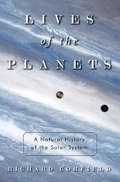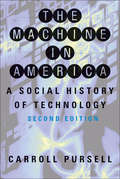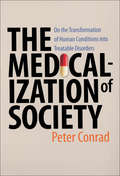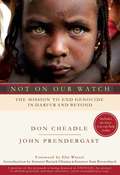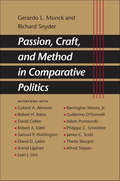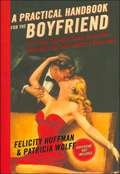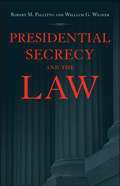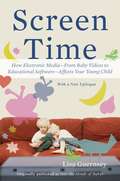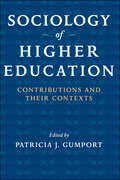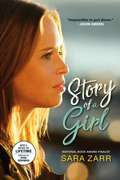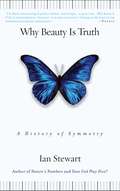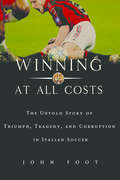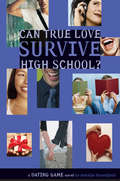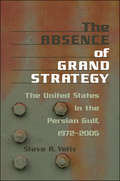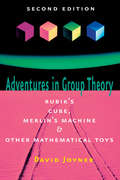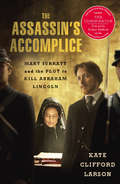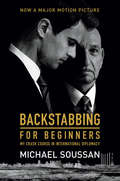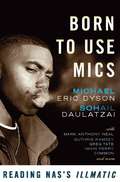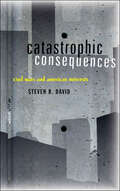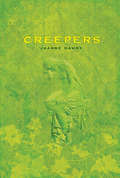- Table View
- List View
Lives of the Planets: A Natural History of the Solar System
by Richard CorfieldLives of the Planets describes a scientific field in the midst of a revolution. Planetary science has mainly been a descriptive science, but it is becoming increasingly experimental. The space probes that went up between the 1960s and 1990s were primarily generalists-they collected massive amounts of information so that scientists could learn what questions to pursue. But recent missions have become more focused: Scientists know better what information they want and how to collect it. Even now probes are on their way to Mercury, Venus, Mars, and Pluto, with Europa-one of Jupiter's moons-on the agenda. In a sweeping look into the manifold objects inhabiting the depths of space, Lives of the Planets delves into the mythology and the knowledge humanity has built over the ages. Placing our current understanding in historical context, Richard Corfield explores the seismic shifts in planetary astronomy and probes why we must change our perspective of our place in the universe. In our era of extraordinary discovery, this is the first comprehensive survey of this new understanding and the history of how we got here.
The Machine in America: A Social History of Technology
by Carroll PursellFrom the medieval farm implements used by the first colonists to the invisible links of the Internet, the history of technology in America is a history of society as well. Arguing that "the tools and processes we use are a part of our lives, not simply instruments of our purpose," historian Carroll Pursell analyzes technology's impact on the lives of women and men, on their work, politics, and social relationships—and how, in turn, people influence technological development.Pursell shows how both the idea of progress and the mechanical means to harness the forces of nature developed and changed as they were brought from the Old World to the New. He describes the ways in which American industrial and agricultural technology began to take on a distinctive shape as it adapted and extended the technical base of the industrial revolution. He discusses the innovation of an American system of manufactures and the mechanization of agriculture; new systems of mining, lumbering, and farming, which helped conquer and define the West; and the technologies that shaped the rise of cities. In the second edition of The Machine in America, Pursell brings this classic history up to date with a revised chapter on war technology and new discussions on information technology, globalization, and the environment.
The Medicalization of Society: On the Transformation of Human Conditions into Treatable Disorders
by Peter ConradOver the past half-century, the social terrain of health and illness has been transformed. What were once considered normal human events and common human problems—birth, aging, menopause, alcoholism, and obesity—are now viewed as medical conditions. For better or worse, medicine increasingly permeates aspects of daily life.Building on more than three decades of research, Peter Conrad explores the changing forces behind this trend with case studies of short stature, social anxiety, "male menopause," erectile dysfunction, adult ADHD, and sexual orientation. He examines the emergence of and changes in medicalization, the consequences of the expanding medical domain, and the implications for health and society. He finds in recent developments—such as the growing number of possible diagnoses and biomedical enhancements—the future direction of medicalization. Conrad contends that the impact of medical professionals on medicalization has diminished. Instead, the pharmaceutical and biotechnical industries, insurance companies and HMOs, and the patient as consumer have become the major forces promoting medicalization. This thought-provoking study offers valuable insight into not only how medicalization got to this point but also how it may continue to evolve.
Not on Our Watch: The Mission to End Genocide in Darfur and Beyond
by Don Cheadle John PrendergastAn Academy Award-nominated actor and a renowned human rights activist team up to change the tragic course of history in the Sudan--with readers' help.While Don Cheadle was filming Hotel Rwanda, a new crisis had already erupted in Darfur, in nearby Sudan. In September 2004, then-Secretary of State Colin Powell termed the atrocities being committed there "genocide"--and yet two years later things have only gotten worse. 3.5 million Sudanese are going hungry, 2.5 million have been displaced by violence, and 400,000 have died in Darfur to date.Both shocked and energized by this ongoing tragedy, Cheadle teamed up with leading activist John Prendergast to focus the world's attention. Not on Our Watch, their empowering book, offers six strategies readers themselves can implement: Raise Awareness, Raise Funds, Write a Letter, Call for Divestment, Start an Organization, and Lobby the Government. Each of these small actions can make a huge difference in the fate of a nation, and a people--not only in Darfur, but in other crisis zones such as Somalia, Congo, and northern Uganda.
Passion, Craft, and Method in Comparative Politics
by Richard Snyder Gerardo L. MunckIn the first collection of interviews with the most prominent scholars in comparative politics since World War II, Gerardo L. Munck and Richard Snyder trace key developments in the field during the twentieth century. Organized around a broad set of themes—intellectual formation and training; major works and ideas; the craft and tools of research; colleagues, collaborators, and students; and the past and future of comparative politics—these in-depth interviews offer unique and candid reflections that bring the research process to life and shed light on the human dimension of scholarship. Giving voice to scholars who practice their craft in different ways yet share a passion for knowledge about global politics, Passion, Craft, and Method in Comparative Politics offers a wealth of insights into contemporary debates about the state of knowledge in comparative politics and the future of the field.
A Practical Handbook for the Boyfriend: For Every Guy Who Wants to Be One/For Every Girl Who Wants to Build One
by Felicity HuffmanMost dating books are written for women -- what a mistake that is. Women know how to date . . . It's men who need the help! At last: a blithe, bold, and bawdy guide to building a better boyfriend At some point, every guy -- player, geek, mama's boy, "regular Joe" -- meets a woman who makes him want to be a boyfriend. A good boyfriend. Problem is, unless he's had some first-rate training (by a previous girlfriend, a sister, a mom), he probably doesn't even know what that means. Felicity Huffman and Patricia Wolff come to the rescue with a rollicking -- and whip-smart -- handbook to navigating the minefield of male-female relationships. Directed at men (though of course it's women who'll buy it, then leave it at their boyfriend's place -- accidentally on purpose), A Practical Handbook for the Boyfriend lays out the many steps involved in becoming a good boyfriend, while still maintaining guy-dignity. It covers issues like: -Who decides when you become a boyfriend (answer: She does.) -How to look like you're listening, even when you're not (If you're busted, just say "You're so pretty, I'm distracted.") -Ten things never to say on the first date (#4: "I just did that to freak you out.") -Finding the middle ground between too cool (think third grade) and too eager (think surprise visits) -Why becoming a good boyfriend is a lot like training for the A team Filled with humor, ribaldry, common sense, and assorted outdoor skills, A Practical Handbook for the Boyfriend is the next dating guide to dominate the bestseller lists.
Presidential Secrecy and the Law
by Robert M. Pallitto William G. WeaverAs seen on The Daily Show, July 24State secrets, warrantless investigations and wiretaps, signing statements, executive privilege—the executive branch wields many tools for secrecy. Since the middle of the twentieth century, presidents have used myriad tactics to expand and maintain a level of executive branch power unprecedented in this nation’s history. Most people believe that some degree of governmental secrecy is necessary. But how much is too much? At what point does withholding information from Congress, the courts, and citizens abuse the public trust? How does the nation reclaim rights that have been controlled by one branch of government?With Presidential Secrecy and the Law, Robert M. Pallitto and William G. Weaver attempt to answer these questions by examining the history of executive branch efforts to consolidate power through information control. They find the nation’s democracy damaged and its Constitution corrupted by staunch information suppression, a process accelerated when "black sites," "enemy combatants," and "ghost detainees" were added to the vernacular following the September 11, 2001, terror strikes.Tracing the current constitutional dilemma from the days of the imperial presidency to the unitary executive embraced by the administration of George W. Bush, Pallitto and Weaver reveal an alarming erosion of the balance of power. Presidential Secrecy and the Law will be the standard in presidential powers studies for years to come.
Screen Time: How Electronic Media-From Baby Videos to Educational Software-Affects Your Young Child
by Lisa GuernseyAs a mother, Lisa Guernsey wondered about the influence of television on her two young daughters. As a reporter, she resolved to find out. What she first encountered was tired advice, sensationalized research claims, and a rather draconian mandate from the American Academy of Pediatrics: no TV at all before the age of two. But like many parents, she wanted straight answers and realistic advice, so she kept digging: she visited infant-perception labs and child development centers around the country. She interviewed scores of parents, psychologists, cognitive scientists, and media researchers, as well as programming executives at Noggin, Disney, Nickelodeon, Sesame Workshop, and PBS. Much of what she found flies in the face of conventional wisdom and led her to conclude that new parents will be best served by focusing on &“the three C&’s&”: content, context, and the individual child. Advocating a new approach to television and DVDs, Guernsey focuses on infants to five-year-olds and goes beyond the headlines to explore what exactly is &“educational&” about educational media. She examines how play and language development are affected by background and foreground television and how to choose videos that are age-appropriate. She explains how to avoid the hype of &“brain stimulation&” and focus instead on social relationships and the building blocks of language and literacy. Along the way, Guernsey highlights independent research on shows ranging from Dora the Explorer to Dragon Tales, and distills some surprising new findings in the field of child development. Into the Minds of Babes is a fascinating book that points out how little credible research exists to support the AAP&’s dire recommendation. Parents, teachers, and psychologists will be relieved to learn positive approaches to using videos with young children and will be empowered to make their own informed choices.
Sociology of Higher Education: Contributions and Their Contexts
by Patricia J. GumportIn this volume, Patricia Gumport and other leading scholars examine the sociology of higher education as it has evolved since the publication of Burton Clark's foundational article in 1973. They trace diverse conceptual and empirical developments along several major lines of specialization and analyze the ways in which wider societal and institutional changes in higher education have influenced this vital field of study.In her own chapters, Gumport identifies the factors that constrain or facilitate the field's development, including different intellectual legacies and professional contexts for faculty in sociology and in education. She also considers prospects for the future legitimacy and vitality of the field.Featuring extensive reviews of the literature, this volume will be invaluable for scholars and students of sociology and higher education.
Story of a Girl (Little Brown Novels)
by Sara ZarrNow a movie on Lifetime! I was thirteen when my dad caught me with Tommy Webber in the back of Tommy's Buick, parked next to the old Chart House down in Montara at eleven o'clock on a Tuesday night. Tommy was seventeen and the supposed friend of my brother, Darren.I didn't love him.I'm not sure I even liked him.In a moment, Deanna Lambert's teenage life is changed forever. Struggling to overcome the lasting repercussions and the stifling role of "school slut," Deanna longs to escape a life defined by her past. With subtle grace, complicated wisdom, and striking emotion, Story of a Girl reminds us of our human capacity for resilience, epiphany, and redemption.
Why Beauty Is Truth: The History of Symmetry
by Ian StewartAt the heart of relativity theory, quantum mechanics, string theory, and much of modern cosmology lies one concept: symmetry. In Why Beauty Is Truth, world-famous mathematician Ian Stewart narrates the history of the emergence of this remarkable area of study. Stewart introduces us to such characters as the Renaissance Italian genius, rogue, scholar, and gambler Girolamo Cardano, who stole the modern method of solving cubic equations and published it in the first important book on algebra, and the young revolutionary Evariste Galois, who refashioned the whole of mathematics and founded the field of group theory only to die in a pointless duel over a woman before his work was published. Stewart also explores the strange numerology of real mathematics, in which particular numbers have unique and unpredictable properties related to symmetry. He shows how Wilhelm Killing discovered "Lie groups” with 14, 52, 78, 133, and 248 dimensions-groups whose very existence is a profound puzzle. Finally, Stewart describes the world beyond superstrings: the "octonionic” symmetries that may explain the very existence of the universe.
Why Beauty Is Truth: The History of Symmetry
by Ian StewartAt the heart of relativity theory, quantum mechanics, string theory, and much of modern cosmology lies one concept: symmetry. In Why Beauty Is Truth, world-famous mathematician Ian Stewart narrates the history of the emergence of this remarkable area of study. Stewart introduces us to such characters as the Renaissance Italian genius, rogue, scholar, and gambler Girolamo Cardano, who stole the modern method of solving cubic equations and published it in the first important book on algebra, and the young revolutionary Evariste Galois, who refashioned the whole of mathematics and founded the field of group theory only to die in a pointless duel over a woman before his work was published. Stewart also explores the strange numerology of real mathematics, in which particular numbers have unique and unpredictable properties related to symmetry. He shows how Wilhelm Killing discovered "Lie groups" with 14, 52, 78, 133, and 248 dimensions-groups whose very existence is a profound puzzle. Finally, Stewart describes the world beyond superstrings: the "octonionic" symmetries that may explain the very existence of the universe.
Winning at All Costs: A Scandalous History of Italian Soccer
by John FootThe 2006 World Cup final between Italy and France was a down-and-dirty game, marred by French superstar Zidane's head-butting of Italian defender Materazzi. But viewers were also exposed to the poetry, force, and excellence of the Italian game; as operatic as Verdi and as cunning as Machiavelli, it seemed to open a window into the Italian soul. John Foot's epic history shows what makes Italian soccer so unique. Mixing serious analysis and comic storytelling, Foot describes its humble origins in northern Italy in the 1890s to its present day incarnation where soccer is the national civic religion. A story that is reminiscent of Gangs of New York and A Clockwork Orange, Foot shows how the Italian game - like its political culture - has been overshadowed by big business, violence, conspiracy, and tragedy, how demagogues like Benito Mussolini and Silvio Berlusconi have used the game to further their own political ambitions. But Winning at All Costs also celebrates the sweet moments - the four World Cup victories, the success of Juventus, Inter Milan, AC Milan, the role soccer played in the resistance to Nazism, and the great managers and players who show that Italian soccer is as irresistible as Italy itself.
Dating Game #3: Can True Love Survive High School? (The\dating Game Ser. #3)
by Natalie StandifordIs it True Love? (Circle the correct answer.) 1. You are dating an incredible boy named Stephen. He's good-looking, sexy, kind, funny, and smart. But you can't stop fantasizing about Sean, the hottest senior in school. Are you really in love with your boyfriend? Yes or No 2. You think about your high school teacher 24/7. You plot to hide in his bedroom closet and surprise him. Are you in love or out of your mind? In Love or Delusional 3. You and your boyfriend, Rob, spend Saturday nights playing video games, sharing pizza, and hanging out with his friends. Is this love or friendship? Boyfriend or Buddy 4. You meet a guy who makes your heart race and your knees weak. You are soul mates, the perfect match, cosmically meant for each other. You decide to bail high school and run away and marry him. Are you in love or brainless? In Love or Crazy Holly, Madison, and Lina are looking for true love. But how can you tell when it's real? What is true love anyway? For the answers, open this book and read on ... because Holly, Madison, and Lina are about to run smack into the truth about love!
The Absence of Grand Strategy: The United States in the Persian Gulf, 1972–2005
by Steve A. YetivGreat powers and grand strategies. It is easy to assume that the most powerful nations pursue and employ consistent, cohesive, and decisive policies in trying to promote their interests in regions of the world. Popular theory emphasizes two such grand strategies that great powers may pursue: balance of power policy or hegemonic domination. But, as Steve A. Yetiv contends, things may not always be that cut and dried. Analyzing the evolution of the United States' foreign policy in the Persian Gulf from 1972 to 2005, Yetiv offers a provocative and panoramic view of American strategies in a region critical to the functioning of the entire global economy. Ten cases—from the policies of the Nixon administration to George W. Bush's war in Iraq—reveal shifting, improvised, and reactive policies that were responses to unanticipated and unpredictable events and threats. In fact, the distinguishing feature of the U.S. experience in the Gulf has been the absence of grand strategy.Yetiv introduces the concept of "reactive engagement" as an alternative approach to understanding the behavior of great powers in unstable regions. At a time when the effects of U.S. foreign policy are rippling across the globe, The Absence of Grand Strategy offers key insight into the nature and evolution of American foreign policy in the Gulf.
Adventures in Group Theory: Rubik's Cube, Merlin's Machine, and Other Mathematical Toys
by David JoynerThis updated and revised edition of David Joyner’s entertaining "hands-on" tour of group theory and abstract algebra brings life, levity, and practicality to the topics through mathematical toys.Joyner uses permutation puzzles such as the Rubik’s Cube and its variants, the 15 puzzle, the Rainbow Masterball, Merlin’s Machine, the Pyraminx, and the Skewb to explain the basics of introductory algebra and group theory. Subjects covered include the Cayley graphs, symmetries, isomorphisms, wreath products, free groups, and finite fields of group theory, as well as algebraic matrices, combinatorics, and permutations.Featuring strategies for solving the puzzles and computations illustrated using the SAGE open-source computer algebra system, the second edition of Adventures in Group Theory is perfect for mathematics enthusiasts and for use as a supplementary textbook.
The Assassin's Accomplice: Mary Surratt and the Plot to Kill Abraham Lincoln
by Kate Clifford LarsonIn The Assassin's Accomplice, historian Kate Clifford Larson tells the gripping story of Mary Surratt, a little-known participant in the plot to kill Abraham Lincoln, and the first woman ever to be executed by the federal government of the United States. Surratt, a Confederate sympathizer, ran the boarding house in Washington where the conspirators-including her rebel son, John Surratt-met to plan the assassination. When a military tribunal convicted her for her crimes and sentenced her to death, five of the nine commissioners petitioned President Andrew Johnson to show mercy on Surratt because of her sex and age. Unmoved, Johnson refused-Surratt, he said, "kept the nest that hatched the egg." Set against the backdrop of the Civil War, The Assassin's Accomplice tells the intricate story of the Lincoln conspiracy through the eyes of its only female participant. Based on long-lost interviews, confessions, and court testimony, the text explores how Mary's actions defied nineteenth-century norms of femininity, piety, and motherhood, leaving her vulnerable to deadly punishment historically reserved for men. A riveting narrative account of sex, espionage, and murder cloaked in the enchantments of Southern womanhood, The Assassin's Accomplice offers a fresh perspective on America's most famous murder.
Backstabbing for Beginners: My Crash Course in International Diplomacy
by Michael SoussanSoon to be a major motion picture starring Ben Kingsley and Theo James, the gripping true story of a young program coordinator at the United Nations who stumbles upon a conspiracy involving Iraq's oil reserves."What made this episode in our collective history possible was not so much the lies we told one another, but the lies we told ourselves."A recent Brown University graduate, Michael Soussan was elated when he landed a position as a program coordinator for the United Nations' Iraq Program. Little did he know that he would end up a whistleblower in what PBS NewsHour described as the "largest financial scandal in UN history."Breaking a conspiracy of silence that had prevailed for years, Soussan sparked an unprecedented corruption probe into the Oil-for-Food program that exposed a worldwide system of bribes, kickbacks, and blackmail involving ruthless power-players from around the globe.At the crossroads of pressing humanitarian concerns, crisis diplomacy, and multibillion-dollar business interests, Soussan's story highlights core flaws of our international system and exposes the frightening, corrupting power of the black elixir that fuels our world's economy.
Backstabbing for Beginners: My Crash Course in International Diplomacy
by Michael SoussanSoon to be a major motion picture starring Ben Kingsley and Theo James, the gripping true story of a young program coordinator at the United Nations who stumbles upon a conspiracy involving Iraq's oil reserves. "What made this episode in our collective history possible was not so much the lies we told one another, but the lies we told ourselves." A recent Brown University graduate, Michael Soussan was elated when he landed a position as a program coordinator for the United Nations' Iraq Program. Little did he know that he would end up a whistleblower in what PBS NewsHour described as the "largest financial scandal in UN history." Breaking a conspiracy of silence that had prevailed for years, Soussan sparked an unprecedented corruption probe into the Oil-for-Food program that exposed a worldwide system of bribes, kickbacks, and blackmail involving ruthless power-players from around the globe. At the crossroads of pressing humanitarian concerns, crisis diplomacy, and multibillion-dollar business interests, Soussan's story highlights core flaws of our international system and exposes the frightening, corrupting power of the black elixir that fuels our world's economy.
Born to Use Mics: Reading Nas's Illmatic
by Michael Eric Dyson Sohail DaulatzaiAt the age of nineteen, Nasir "Nas” Jones began recording tracks for his debut album-and changed the music world forever. Released in 1994, Illmatic was hailed as an instant masterpiece and has proven one of the most influential albums in hip-hop history. With its close attention to beats and lyricism, and riveting first-person explorations of the isolation and desolation of urban poverty, Illmatic was pivotal in the evolution of the genre.In Born to Use Mics, Michael Eric Dyson and Sohail Daulatzai have brought together renowned writers and critics including Mark Anthony Neal, Marc Lamont Hill, Eddie S. Glaude, Jr., and many others to confront Illmatic song by song, with each scholar assessing an individual track from the album. The result is a brilliant engagement with and commentary upon one of the most incisive sets of songs ever laid down on wax.
Born to Use Mics: Reading Nas's Illmatic
by Michael Eric Dyson; Sohail DaulatzaiAt the age of nineteen, Nasir "Nas" Jones began recording tracks for his debut album -- and changed the music world forever. Released in 1994, Illmatic was hailed as an instant masterpiece and has proven one of the most influential albums in hip-hop history. With its close attention to beats and lyricism, and riveting first-person explorations of the isolation and desolation of urban poverty, Illmatic was pivotal in the evolution of the genre. In Born to Use Mics, Michael Eric Dyson and Sohail Daulatzai have brought together renowned writers and critics including Mark Anthony Neal, Marc Lamont Hill, Eddie S. Glaude, Jr., and many others to confront Illmatic song by song, with each scholar assessing an individual track from the album. The result is a brilliant engagement with and commentary upon one of the most incisive sets of songs ever laid down on wax.
Catastrophic Consequences: Civil Wars and American Interests
by Steven R. DavidCivil war and other types of radical domestic upheaval are replacing international war as the preeminent threat to American security and economic well being, according to Steven R. David. Catastrophic Consequences argues that civil conflicts are of even greater importance than deliberate efforts to harm the United States because the damage they inflict is unintended and therefore impossible to deter.David examines the prospects for and potential aftereffects of instability in four nations vital to U.S. national interests—Saudi Arabia, Pakistan, China, and Mexico. It is not, he argues, a rising China that threatens America, but one that is falling apart. Likewise, it is not a hostile Pakistani regime over which the United States should worry, rather it is one that cannot keep the country together. Similarly, a conflict-torn Mexico or Saudi Arabia poses a far greater danger to America than does either of those states growing stronger. In assessing these threats, David contends that the United States’s only viable option is to view other-state civil upheaval similarly to natural disasters and to develop a coherent, effective emergency response mechanism, which does not exist today in any systemic, nationwide form.
Clique Summer Collection #4:Kristen (The Clique #No. 4)
by Lisi HarrisonKristen sets sail on the Love Boat... With the rest of the Pretty Committee scattered across the globe, Kristen is stuck in summer school at OCD, making good on her scholarship commitments. No sleepover horse camp, no Hawaiian spa, no Spanish vacation, not even a trip to Orlando. But when Kristen scores a job looking after hang-ten hottie Dune Baxter's eight-year-old sister, Ripple, Westchester suddenly doesn't seem so bad. It looks like Kristin is about to ride the wave of first love. . . .
Clique Summer Collection #5: Claire (The Clique #Bk. 5)
by Lisi HarrisonWill Claire's Florida BFFs become former BFFs? Back in Orlando for the summer, Claire is reunited with her Florida best friends, Sarah, Sari, and Mandy, after a long year apart. Her FBFs haven't changed at all. Too bad they think Claire has . . . and not for the better. Claire sets out to prove her loyalty by entering Kissimmee's Miss Kiss pageant. But when a very special visitor shows up and vows to win the crown, Claire finds herself torn between Keds and couture. Will Claire finally kiss-immee her past goodbye-once and for all?
Creepers
by Joanne DahmeFrom moving to a new house to making new friends and preparing for high school, life for the new girl in town can be unsettling. But thirteen year-old Courtney is unprepared for how creepy life in Murmur, Massachusetts turns out to be. Her ivy-covered house overlooking the antiquated cemetery next door is one thing, but Courtney finds herself thrust into a full-fledged haunted adventure after meeting Christian and Margaret Geyer, a strange father and daughter with unfinished family business. The body of their ancestor, Prudence, has gone missing from beneath her ivy-carved tombstone and must be returned to its final resting place in order to break the spell that looms over Courtney's house. To add to the suspense and help solve the mystery, authentic documents and photographs are set at the beginning of each chapter pertaining to Murmur, Courtney's house, and the infamous cemetery. Will Courtney uncover the secret lurking within the dark, dank underbelly of her ivy-covered basement?
